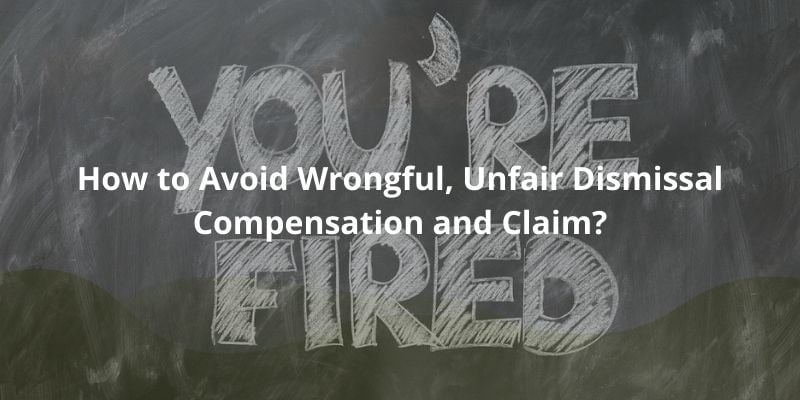Avoiding Litigation: Strategies for Preventing Wrongful and Unfair Dismissal Compensation Claims
7 Dec 2023
5 Jul 2020
min read

As an employer, dismissal of your employees is inevitable and is something you will have to do at some point. The Dismissal of an employee refers to the process by which an employer terminates a contract, and can occur for many reasons - the employee may have underperformed, been negligent, or may have simply been a bad fit. In this article, we will be setting out the various ways you can lay off an employee to minimise the possibility of potential lawsuits arising for wrongful or unfair dismissal claims (where the dismissed employee seeks unfair dismissal compensation). We will also give you ideas as to preventative measures to implement. It is in your best interest to make a challenging process run a bit smoother by following the correct measures.
Below are the steps you should take as an employer to protect yourself and your company to defend wrongful or unfair dismissal claims.
A. What are wrongful and unfair dismissal claims?
Employment regulations differ throughout jurisdictions, but there is a consensus as to when an employee can or cannot be terminated.
Wrongful dismissal is where the dismissal is in breach of the employee’s contract. Rather than being a statutory claim protected by the law, this dismissal deals with the contract signed by the two parties as employer and employee.
A common example of wrongful dismissal is where an employee is dismissed without prior notice as set out in the employment agreement. In some jurisdictions, contradicting the policy in the company handbook constitutes wrongful dismissal even if the employee did not sign or agree to that policy in the company handbook.
Unfair dismissal, on the other hand, is where an employer terminates employment without a demonstrable reason, therefore violating the statute. Circumstances constituting unfair dismissal include dismissing a pregnant employee or dismissing based on race.
Most countries have a statute that prevents employers from dismissing employees for reasons relating to gender, race, sexual identity, and age. You should also note that in some jurisdictions, unfair dismissal includes dismissals that are reasonable but do not follow the correct procedure.

B. What is a fair dismissal?
Now that we have covered unfair dismissals, what constitutes a fair dismissal? Fair dismissals are conducted based on reasons which do not fall into either of the above categories. Depending on the jurisdiction, these can include:
-
Unacceptable workplace conduct
-
Under-qualification or capability mismatch of the employee with the work tasks required
-
Employee redundancy caused by insufficient work or market conditions
-
Statutory duties or restrictions which prohibit employment (e.g. visa issues, age restrictions)
-
A substantial reason which justifies dismissal
C. How is Unfair Dismissal Compensation Calculated?
The calculation of unfair dismissal compensation varies from country to country, but generally, it is done so considering the following factors:
-
How much money can the employee make if not dismissed is the starting point for any compensation?
-
How much money the employee has made since the dismissal is to be subtracted from the amount above.
-
Any reduction in compensation resulting from the employee's misconduct relating to the dismissal.
-
What steps the employee has taken to mitigate the losses (any proactive step to finding a job).
-
Any compensation cap imposed by the country (if any) - generally compensation will not be unlimited.
D. How can I prevent being accused of wrongfully or unfairly dismissing an employee?
Since the three categories above are defined so widely, your main concern as an employer, therefore, is to avoid being wrongfully accused of wrongfully or unfairly dismissing an employee.
While the process of dismissal is complicated and risky, it is a necessary one. It is fundamental for employers to tackle dismissal properly to avoid short and long-term repercussions including legal costs and potentially a destroyed company reputation.
Read on for some tips on handling dismissals properly to avoid litigation:
1. Give the Employee a Chance to Improve
When you see an employee acting in a dissatisfactory way, before simply resorting to dismissing them, it is important to give them a chance to improve. Your employees may be inexperienced or unfamiliar with the company culture; dismissing them outright may not be reasonable. Instead, it might be more appropriate to give them a warning first by making it clear that their employment is at risk unless they rectify the situation. It would be best to put the warning in writing to have proof of the dismissal process in case of a trial.
If you are looking to give your employee a warning, please see the below links for templates of warning letters to your employees:
|
Employee warning letter
|
https://docpro.com/doc1080/employee-warning-letter-employer-favoured
|
|
Notification to Employee - Warning of poor performance |
https://docpro.com/doc748/notification-to-employee-staff-warning-poor-performance
|
|
Notification to Employee - Review to improve performance |
https://docpro.com/doc742/notification-to-employee-staff-review-to-improve-performance
|
2. There Must be a Valid Reason for Dismissal
If you are considering dismissing a certain employee, you must ensure that you have a valid and reasonable reason for dismissing that employee. That reason must be related to their capability or conduct, must be sound and well-founded, and cannot be out of prejudice or bias.
Reasons for dismissal may vary by jurisdiction but generally, concerning capability, employees may be dismissed due to not having the requisite technical skills, their inability to fulfil a language requirement, or taking unreasonable long-term absences from work.
Regarding conduct, employees may be dismissed for being repeatedly late to work, being drunk, acting inappropriately towards other coworkers, or not working during work hours.
As stated earlier, there are certain reasons you cannot use as a basis to dismiss an employee. These reasons include gender, race, pregnancy, sexuality, and age. In some jurisdictions, it is illegal to fire your employee for those reasons, and if it is discovered that you have done so, you will be considered as acting contrary to the law. It, therefore, remains essential that you ensure you are dismissing an employee for a valid reason.

3. The Employee Must be Notified of the Reason for Their Dismissal
On top of having a valid reason, you should ensure that your employee is notified of the reason for their dismissal. This must be done before they are officially terminated, not for any legal requirements, but out of common courtesy.
You have to place yourself in your employee’s shoes. From their perspective, it is reasonable that they would want to know exactly why they are being dismissed. Knowing the reasons for dismissal not only provides them with closure but enables them to change their behaviour and improve in the future.
If you can provide them with a valid and substantiated reason, it is more likely that the employee will accept the decision of the termination without questions or causing a scene. By conducting the dismissal on amicable terms, the chances of litigation are less likely.
You should note that the notice period for dismissal should be in accordance with the stipulated time in the employment contract. The dismissal, as well as the reason for dismissal, should be in writing, to serve as a written record.
The following are customisable templates you can use once you decide to take action and terminate an employee:
|
Employee termination letter |
https://docpro.com/doc1071/employee-termination-letter-employer-favoured |
|
A termination notice to an employee - Misconduct |
https://docpro.com/doc744/termination-notice-to-employee-staff-misconduct
|
|
A termination notice to an employee - Poor performance |
https://docpro.com/doc746/termination-notice-to-employee-staff-poor-performance
|
|
A termination notice to an employee - Layoff |
https://docpro.com/doc743/termination-notice-to-employee-staff-layoff
|
|
A termination notice to an employee - Absence from work |
https://docpro.com/doc745/termination-notice-to-employee-staff-absence-from-work
|
4. Give the employee a chance to respond
After the termination notice has been served, the employee must be allowed to respond to the reason for dismissal. Remember that your employees are just people, and it is important to understand their needs and respond to them appropriately.
They might be having a personal crisis, hardship, or experiencing difficulties in the workplace. Regardless of the situation, always remain empathetic by listening to them and keeping an open mind.
If after the meeting you find that the situation is salvageable, you can choose to rescind your termination notice. If an acceptable compromise cannot be found, then going ahead with the termination may be the best option.
It is also smart to keep a record of the meetings such that if the employee continues to act in a dissatisfactory after being warned and promising to improve, you have more of a reason to terminate their employment and dismiss them.
5. Provide Support to the Employee
In the course of the termination and dismissal process, the employee should be allowed to have a support person present. While you are not legally obliged to make this happen, helping them sort out a suitable arrangement would reflect your compassion as an employer and help the employee feel less intimidated.
During dismissal, the employee may feel like there is a great power imbalance as they are up against a corporation. Having a support person would help them to feel at ease, making discussions smoother overall.
6. Follow Dismissal Protocol
As previously stated, even if the reason for dismissal is neither unreasonable nor unfair, the termination procedure may be invalidated if proper dismissal protocol is not followed. You must therefore ensure that any allegations against the employee are investigated thoroughly and proven to be true.
You must also ensure that the termination is compliant with company policy and any other policy or agreement stated in the employment contract. If you have Human Resources (HR) staff, you may want to get their help to ensure protocol is being followed. Failure to follow procedure and company policy may lead to a successful unfair dismissal claim on the grounds of procedural irregularity.

D. Other general management and preventative measures
Aside from what we covered above, there are many things you can do as an employer to prevent being accused of wrongful or unfair dismissal before you even commence the dismissal.
1. Establish Roles and Duties of Your Employees
When onboarding, it is important to clearly establish the roles and duties of your employees. Employees should clearly understand what has expected of them as well as their responsibilities in the office.
If their roles and responsibilities are not expected to change in the course of their employment, it is ideal to detail their roles and responsibilities in their employment contract. Also, make it clear which members of staff are allowed to hire and terminate employees, as this will establish a hierarchy of staff for employees to answer to. Setting out this detail will help avoid confusion regarding their respective responsibilities and roles in the office, and serve as evidence against them if any conflict arises.
2. Set Up Employees Protocol and Dismissal Procedures
Employers can set up a protocol that addresses dismissal procedures. This might include requirements such as the dismissal notices to be in writing, mandatory meetings before dismissal, and even that to keep a record of what is discussed in meetings and other exchanges in the workplace.
Having a concrete framework prevents misunderstanding between you and your employees regarding the process of dismissal and what rights they have. Having protocol that requires everything to be in writing also ensures that there is a record of evidence, supporting any claims you may make in court. It would also be a good idea to have a human resources representative who is trained to handle such protocol and different types of workplace conflict.
3. Foster a Good and Harmonious Working Environment
Often, conflict in the workplace arises due to differences in opinion, behaviour, and personality. This is natural and is difficult to avoid, as small conflicts which arise from inherent differences tend to escalate and open up conflicts that become grounds for dismissal. However, it can be prevented to some extent by creating and fostering a harmonious workplace environment.
Employers can foster a good and harmonious workplace environment by implementing team-building exercises.
This can include weekly meetings to discuss expectations, team-building events to foster healthy relationships and feedback sessions for employees to ask questions and discuss issues with their superiors.
4. Can I dismiss an Employee Immediately without following Protocols and Procedures?
You may be able to dismiss an employee immediately in certain situations, for example, where there is gross misconduct. In this circumstance, while you do not need to give an employee additional pay or notice, you ensure you have records and evidence of misconduct in case it is challenged by the employee. You might also want to consider giving the employee pay in lieu of notice when you are dismissing him or her. Ideally, you would get them to leave as soon as reasonably possible, as they may steal your customers, and business secrets, create havoc on your company or spread rumours amongst other employees.
That said, on-the-spot dismissals should be avoided as much as possible. Unlike those we see in the movies, real on-spot-dismissals cause a large amount of strife, blatantly go against proper procedure and often cause problems in terms of the protocol as well as potential litigation. Of course, there may be circumstances in which an employee acts so unreasonably you want to dismiss them on the spot. However, we would caution against this - you should ensure that there is another manager or senior supervisor in the room to diffuse and evaluate the situation before you decide to dismiss them.
E. Conclusion
Dismissals are a difficult yet essential process of running a business. You must go about it carefully - dismissing employees improperly can lead to litigation concerning wrongful or unfair dismissal, which would only cause damage to your company’s image.
Despite the risks, employers should not retain unsuitable employees out of fear of legal repercussions but should take positive steps to protect themselves from the possibility of litigation. The more positive steps taken, the more amicable dismissals will be, and the less likely you will suffer repercussions as an employer.
Please note that this is just a general summary about unfair dismissal under common law and does not constitute legal advice. As the laws of each jurisdiction may be different, you may want to speak to your local legal adviser.
Keywords:

